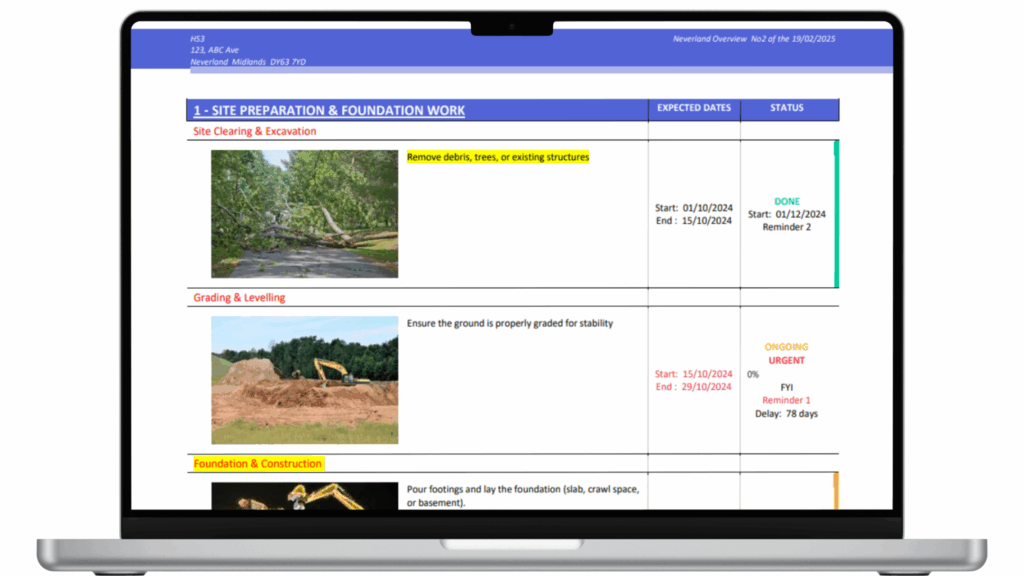A construction site report (or site progress report) is an essential document in the construction industry. It records all relevant information related to the construction site, focusing on monitoring progress, issues encountered, resources used, and more. In short, it provides a daily snapshot of what’s happening on site. This report is crucial for communication between all project stakeholders and serves as a foundation for informed decision-making. Writing it carefully and including all necessary information is therefore vital. In this article, we explain how to create an effective construction site report in practice.
What Is a Construction Site Report and Why Is It Important?
A construction site report is a detailed document that tracks the work performed, materials used, labor involved, and equipment deployed on a construction site during a specific period.
It provides traceability of:
- Work completed
- Materials consumed
- Workforce and equipment used
At the same time, it acts as a central communication tool to keep all stakeholders aligned and informed.
The report is also used to evaluate project progress, identify risks or delays, and support decision-making to keep the project on schedule.

NOTE : While not legally mandatory, construction site reports are often used to comply with regulations, support audits, and resolve disputes with clients if necessary.
Key Elements to Include in Your Construction Site Report
To be effective and useful, your site report should contain the following core elements:
- General information: report date, site address, names of people present during the report preparation
- Summary of activities: overview of work completed since the last report
- Issues encountered: delays, material shortages, safety incidents, etc.
- Resources used: labor, materials, equipment, machinery
- Upcoming tasks: planned activities and deadlines
NOTE : Adding photos, annotated plans, inspection reports, and permits can provide valuable visual evidence of progress or problems.
How to Write a Construction Site Report in Practice
1. Collect All Relevant Site Information
Before writing your report, gather all necessary information about the site activities and events since the previous report.
Sources include:
- Meeting notes
- Personal observations
- Inspection reports
This ensures you don’t miss any important details.
To simplify note-taking, consider using digital tools like Site Supervision’s free Notes Libres app. It allows you to write, format, and attach photos to your notes directly on site. If you’re a Site Supervision client, you can also transfer these notes directly into the site report module, saving time and avoiding double data entry.
2. Structure Your Report Clearly
Organize your report into clear sections such as:
- Work performed
- Issues encountered
- Resources used
A logical structure improves readability and helps stakeholders quickly find the information they need.
3. Introduce the Report
Start with a brief introduction outlining:
- The report’s purpose
- Date of the report
- Project name and site location
- Names of people present during report preparation
4. Summarize Site Activities
Provide a clear and concise summary of the main activities and progress since the last report.
Include:
- Tasks completed
- Objectives achieved
- Significant events on site
Use straightforward language and avoid unnecessary jargon. Be concise and avoid repetition to communicate effectively.
If possible, list resources used during the reporting period: labor hours, material quantities, equipment, and machinery. Mention quantities, costs, and stock levels. While not mandatory, this helps optimize site management.
NOTE : Report facts objectively and avoid subjective opinions.
5. Report Issues and Challenges
Document any problems encountered on site, explaining their impact on the project and measures taken to resolve them.
Transparency builds trust and credibility with stakeholders—even when reporting setbacks.
To clarify issues, attach annotated plans highlighting problem areas. For example, if a drywall section requires rework, the project manager can mark it clearly on the plan with a revision bubble. This helps teams quickly identify affected areas and understand the scope of work needed.
NOTE : Support your statements with concrete examples, data, and photos to strengthen your report’s credibility.
6. Provide Recommendations and Next Steps
Optionally, suggest recommendations to address issues and improve site processes.
Describe clear, actionable steps to implement these recommendations.
7. Conclude the Report
End with a conclusion summarizing key points and highlighting next steps to keep the project on track.
Before finalizing, proofread carefully to correct any grammar, spelling, or factual errors and ensure consistency.
NOTE : Use digital tools to simplify reporting, keeping a continuous record of site information throughout the project makes report writing easier.
How Can Site Supervision Help You With Your Reporting
Project management tools like Site Supervision’s site report module, meeting notes, and inspection reports help you collect precise and comprehensive data.
Site Supervisions’s mobile and tablet-friendly interface lets you draft reports directly on site, eliminating the need to retype handwritten notes back at the office. This saves time and improves accuracy.
Frequently Asked Questions (FAQ)
Why is a construction site report important?
It documents daily activities, progress, and issues, ensuring traceability and effective communication among project stakeholders.
How can I write an effective site report?
Be precise, concise, and objective. Organize information logically, provide concrete examples, and include clear recommendations. Use digital tools to streamline the process.
What are the benefits of using software for site reports?
Software simplifies report writing, improves data accuracy, enables real-time updates, and facilitates communication between teams on and off site.
By following these best practices, your construction site reports will become powerful tools that enhance project transparency, improve communication, and support successful project delivery.




